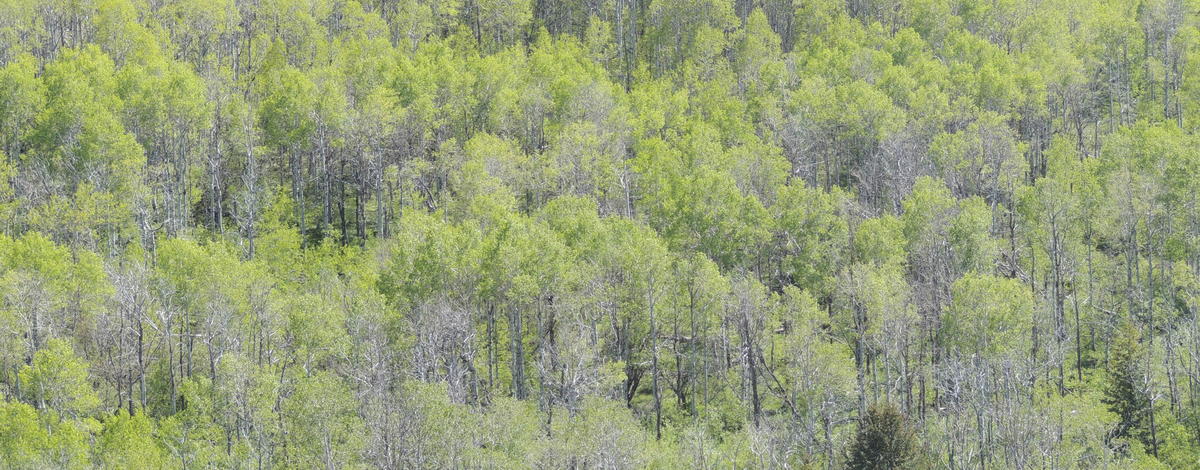Mule Deer and Aspen
Mule deer are an important species to the state of Idaho. Every year people enjoy mule deer through hunting them or watching them afield. Each year 63,000 mule deer hunters enter the field to hunt this iconic western species. Unfortunately, mule deer are experiencing a population decline across the western United States, and Idaho is no exception to this trend. Due to the previously stated facts above, the Idaho Department of Fish and game began the Mule Deer Initiative (MDI) in 2004. The MDI is an IDFG priority program focused on improving mule deer habitat, increasing mule deer populations, and mule deer hunter satisfaction. Habitat improvement at a landscape level is the primary focus of the MDI. While MDI is a statewide program, the focus area for MDI is in the Southern and Southeastern portions of the state, overlapping the focus for the Eastern Idaho Aspen Local Working Group.
Because of IDFG’s commitment to MDI as a priority program, the Department is very interested in improving the various components of mule deer habitat, a critical one of these being quaking aspen. Aspen is considered a keystone species and an indicator of ecological integrity and biodiversity (Di Orio et al. 2005). Aspen communities play a large role in mule deer ecology from gestation through adulthood. While winter forage has often been considered the limiting factor of mule deer, it may actually be summer range nutrition that plays a more critical role in mule deer populations. For example, Tollefson et al. (2010) recently investigated the effects of nutrition on mule deer production and concluded that summer forage has the greatest impact on mule deer populations. Nutrition affects juvenile survival, age of first reproduction, pregnancy, birth mass and adult survival (Bender et al. 2007, Bishop et al. 2009, Tollefson et al. 2010). Lactation is the most nutritionally demanding part of the annual nutritional cycle (Sadleir 1982,), leading researchers to conclude that summer nutrition may be more important to population growth than winter nutrition (Cook et al. 2004).
Aspen stands can provide high quality forage with the added bonus of hiding and thermal cover. Aspen communities have long been described as critical summer habitat for mule deer, because they often contain a rich diversity of forbs, grasses, and shrubs that provide cover and forage (Leckenby et al. 1982, Beck and Peek 2005). Leckenby et al. (1982) identified aspen as important for hiding and thermal cover, forage, fawning, and fawn rearing. They also ranked aspen as highly important during the summer, spring, and fall. Aspen was listed as the fourth most important food item for mule deer by Kufeld et al. (1973).
Unfortunately, aspen communities are steadily decreasing within the state of Idaho. The Bridger-Teton Forest, in the analysis carried out in their last Forest Plan, identified the need to treat about 2,000 ha (4,900ac) of aspen annually to maintain aspen stands currently occurring on the forest. This situation is similar across the various forest districts within the East Idaho Aspen Working Groups focus area.
by Corey Class
This is an excerpt from the Aspen Toolbox, Commonsense guidelines when managing aspen. The Aspen Toolbox was prepared by the East Idaho Aspen Working Group Technical Committee to aid managers in aspen management in Southern and Eastern Idaho.
Literature Cited
Beck, J.L., and J. Peek. 2005. Great Basin summer range forage quality: do plant nutrients meet elk requirements? Western North American Naturalist 65:516-527.
Bender, L. C., L. A. Lomas, and J. Browning. 2007. Condition, survival, and cause-specific mortality of adult female mule deer in north-central New Mexico. Journal of Wildlife Management 71:1118-1124.
Bishop, C. J., G. C. White, D. J. Freddy, B. E. Watkins, and T. R. Stephenson. 2009. Effect of enhanced nutrition on mule deer population rate of change. Wildlife Monographs 172.
Cook, J. G., B. K. Johnson, R. C. Cook, R. A. Riggs, T. Delcurto, L. D. Bryant, and L. L. Irwin. 2004. Effects of Summer-Autumn Nutrition and Parturition Date on Reproduction and Survival of Elk. Wildlife Monographs:1-61.
Di Orio, A. P., R. Callas, and R. J. Schaefer. 2005 Forty-eight year decline and fragmentation of aspen (Populus tremuloides) in the South Warner Mountains of California. Forest Ecology and Management 206:307-313.
Kufeld, R. C., O. C. Wallmo, and C. Feddema. 1973. Foods of the Rocky Mountain mule deer. USDA Forest Service Research. Paper RM-111, Fort Collins, Colorado.
Leckenby, D.A., Sheehy, D.P., Nellis, C.H., Scherzinger, R.J., Luman, I.D., Elmore,W., Lemos, J.C.,Doughty, L. & Trainer, C.E. 1982: Wildlife Habitats in Managed Rangelands - The Great Basin of Southeastern Oregon - Mule Deer. - USDA Forest Service and USDI Bureau of LandManagement General Technical ReportRNW-139, Portland, Oregon, USA, 40 pp.
Sadleir, R. M. F. S. 1982. Energy consumption and subsequent partitioning in lactating black-tailed deer. Canadian Journal of Zoology 60:382-386.
Tollefson, T. N., L. A. Shipley, W. L. Myers, D. H. Keisler, and N. Dasgupta. 2010. Influence of summer and autumn nutrition on body condition and reproduction in lactating mule deer. The Journal of Wildlife Management 74:974-986.

